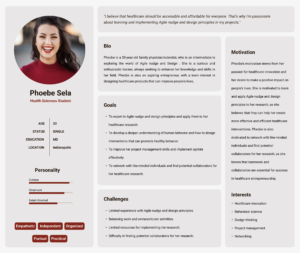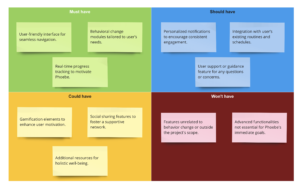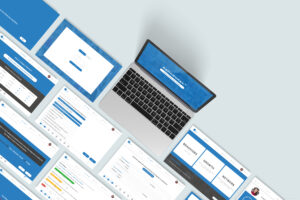Designing for Behavioral Change
PROJECT TYPE | Healthcare System
TIMELINE | June – December 2023
ROLE | Product Manager – UX Researcher/ Designer – UI Designer
TEAM | Fereshteh Shojaei; Fatemeh Shojaei; Vrushab Hanumesh
TOOLS | Figma; Miro
OVERVIEW
AgileNudge+ is a pioneering web-based application that redefines behavior change by leveraging Agile science and Nudge strategies. Unlike conventional journaling and behavior modification solutions, AgileNudge+ adopts a dynamic approach to learning, offering a diverse array of resources and perspectives to address behavior from various angles. Its standout features include online resources, networking groups, and a comprehensive tracking dashboard, fostering user engagement, motivation, and enthusiasm for learning while empowering them to achieve their maximum potential.
PROBLEM STATEMENT
“How might we create a solution that effectively facilitates behavior change and personal growth, overcoming the limitations of traditional journaling and behavior modification methods, to empower individuals to reach their full potential?”
RESEARCH
USER GROUP | Professionals working within healthcare systems aiming at exploring innovative solutions for behavior change and personal development.
FOCUS GROUPS | As part of our project, we facilitated several informal focus group sessions with stakeholders and potential users. The primary aim was to delve deeper into their current practices regarding behavior tracking and initiating changes in their routines. Through these sessions, we sought to gain valuable insights into the strategies, tools, and methods they currently employ to monitor and modify their behaviors. These discussions provided us with a comprehensive understanding of their needs, challenges, and preferences, which will inform the development of our solution.
USER INTERVIEW | We conducted interviews with both potential users and stakeholders to gain a comprehensive understanding of their perspectives, needs, and expectations. By engaging with both sides, we sought to uncover their perceived requirements as well as the underlying needs driving their behaviors. Through these interviews, we aimed to elucidate not only what they believe they need but also what they truly require to effectively track their behaviors and initiate meaningful lifestyle changes.
USER PERSONA | After synthesizing the qualitative data gathered from focus groups and interview, our team created the persona for this project. Phoebe, a 33-year-old family physician and scientist, seeks to integrate Agile science into her profession to drive behavioral changes. Her persona was created from real-world insights, reflecting her goals and challenges related to Agile science or those that can be addressed using Agile Science principles.

USER JOURNEY MAP |After crafting Phoebe’s persona, a detailed user journey map was constructed to visualize her interactions with the current product(s) throughout various stages. This map delineates key touchpoints and highlights areas where additional user research is imperative to optimize the overall user experience. The process of creating Phoebe’s user journey map commenced with extensive discussions with stakeholders and potential users to elucidate their objectives and pain points concerning the prevailing Agile innovation, implementation, and diffusion protocols established by Indiana University School of Medicine’s Center for Health Innovation and Implementation Science (CHIIS) scientists. Phoebe’s journey map traces her initial aspirations within healthcare research, her navigation through obstacles, her exploration of Agile science principles, her integration of software tools, and ultimately, her journey towards transformative success.

CONCEPT GENERATION
MoSCoW METHOD | In the user-centered design methodology adopted for our project, prioritizing end users’ needs, objectives, and satisfaction was paramount, ensuring ease of comprehension and task completion. To effectively address these considerations, we implemented the MoSCoW method for the persona. Requirements were categorized into ‘Must have,’ ‘Should have,’ ‘Could have,’ and ‘Would have/Won’t have’ categories. ‘Must-have’ requirements are pivotal for meeting business needs and ensuring project success. ‘Should have’ requirements are desirable but not pivotal, while ‘Could have’ requirements are regarded as advantageous features. ‘Would have/Won’t have’ requirements are addressed based on varying priorities and may be deferred to future iterations, with features that we should abstain from incorporating into the project.

ITERATIVE CONCEPT DEVELOPMENT | The team engaged in weekly brainstorming and sketch-storming sessions and iterated on design concepts a total of 11 times over a 3-month period. This iterative approach allowed for the exploration of diverse ideas and the refinement of design concepts to align closely with project objectives and user needs.
WIREFRAMING & PROTOTYPING
Following the initial research and design phases, mid-fidelity and high-fidelity MVPs were developed. In the mid-fidelity phase, Figma was employed to create and refine conceptual sketches, resulting in an interactive prototype of AgileNudge+. This phase facilitated clarity in design concept, user expectation alignment, and initial stakeholder and user testing for optimal usability. Transitioning to high-fidelity MVPs involved a collaborative effort with developers, spanning seven week-long sprints for iterative testing cycles of AgileNudge+.

DESIGN
HOMEPAGE | The final concept featuring three primary modules: Behaviors, Growth, and Network upon sign-in or initial registration on AgileNudge+. Additionally, a “Highlights” section offers updates and insights from CHIIS. In the Behaviors section, users initiate a transformative journey through a two-step process: Nudge and Sprint. This section facilitates behavior documentation, stakeholder identification, nudge creation, and success planning. The Growth section allows users to access resources, develop skills, and participate in CHIIS events. Meanwhile, the Network section encourages users to engage in group activities, share ideas, and find community support.

During the specified timeline, the project focuses solely on developing the Behaviors section, emphasizing key features and steps as follows:
MAPPING THE JOURNEY | AgileNudge+ provides a visual map for tracking current and ideal behavior, stakeholders, nudges, and interconnections. This map aids in recalling elements post-mission completion.
BLUEPRINTS | Users receive concise summaries of nudge and sprint missions upon completion, available for future reference or sharing.
GAMIFIED FEATURES | A scoring system enhances engagement, with users earning points for completing missions. A dynamic point bar visually tracks progress, with a maximum cumulative score of 100 points, offering a visual representation of the user’s score throughout the behavioral change journey.
THINGS I LEARNED
- Collaborating with a diverse team of stakeholders, developers, and end-users provided invaluable insights into their perspectives and thought processes. Working closely with users allowed for a deeper understanding of their envisioned behaviors and needs.
- Engaging with professionals such as MDs initially presented challenges in eliciting insights due to hesitancy. We adapted our approach by leveraging trusted connections, attending relevant meetings, and establishing rapport to foster trust and facilitate open communication.
- Throughout the interviews, we learned to prioritize and address critical issues while balancing the team’s objectives and user requirements effectively. This experience underscored the importance of scoping and problem-solving in a collaborative setting.
- Managing a geographically dispersed team across various cities in the US posed coordination challenges during remote work. Despite this, the project provided valuable lessons in navigating diverse expertise levels, enhancing remote collaboration skills, and conducting effective usability testing sessions remotely.